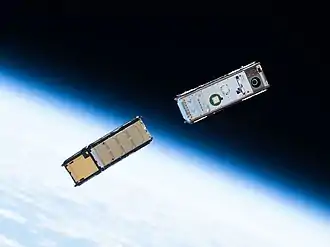
A satellite or artificial satellite[lower-alpha 1] is an object, typically a spacecraft, placed into orbit around a celestial body. Satellites have a variety of uses, including communication relay, weather forecasting, navigation (GPS), broadcasting, scientific research, and Earth observation. Additional military uses are reconnaissance, early warning, signals intelligence and, potentially, weapon delivery. Other satellites include the final rocket stages that place satellites in orbit and formerly useful satellites that later become defunct.
Except for passive satellites, most satellites have an electricity generation system for equipment on board, such as solar panels or radioisotope thermoelectric generators (RTGs). Most satellites also have a method of communication to ground stations, called transponders. Many satellites use a standardized bus to save cost and work, the most popular of which is a small CubeSats. Similar satellites can work together as groups, forming constellations. Because of the high launch cost to space, satellites are designed to be as lightweight and robust as possible. Most communication satellites are radio relay stations in orbit and carry dozens of transponders, each with a bandwidth of tens of megahertz.
Satellites are placed from the surface to the orbit by launch vehicles, high enough to avoid orbital decay by the atmosphere. Satellites can then change or maintain the orbit by propulsion, usually by chemical or ion thrusters. As of 2018, about 90% of the satellites orbiting the Earth are in low Earth orbit or geostationary orbit; geostationary means the satellites stay still in the sky. Some imaging satellites chose a Sun-synchronous orbit because they can scan the entire globe with similar lighting. As the number of satellites and space debris around Earth increases, the threat of collision has become more severe. A small number of satellites orbit other bodies (such as the Moon, Mars, and the Sun) or many bodies at once (two for a halo orbit, three for a Lissajous orbit).
Earth observation satellites gather information for reconnaissance, mapping, monitoring the weather, ocean, forest, etc. Space telescopes take advantage of outer space's near perfect vacuum to observe objects with the entire electromagnetic spectrum. Because satellites can see a large portion of the Earth at once, communications satellites can relay information to remote places. The signal delay from satellites and their orbit's predictability are used in satellite navigation systems, such as GPS. Space probes are satellites designed for robotic space exploration outside of Earth, and space stations are in essence crewed satellites.
The first artificial satellite launched into the Earth's orbit was the Soviet Union's Sputnik 1, on October 4, 1957. As of December 31st 2022, there are 6,718 operational satellites in the Earth's orbit, of which 4,529 belong to the United States (3,996 commercial), 590 belong to China, 174 belong to Russia, and 1,425 belong to other nations.[1]
History
Early proposals
The first published mathematical study of the possibility of an artificial satellite was Newton's cannonball, a thought experiment by Isaac Newton to explain the motion of natural satellites, in his Philosophiæ Naturalis Principia Mathematica (1687). The first fictional depiction of a satellite being launched into orbit was a short story by Edward Everett Hale, "The Brick Moon" (1869).[2][3] The idea surfaced again in Jules Verne's The Begum's Fortune (1879).
In 1903, Konstantin Tsiolkovsky (1857–1935) published Exploring Space Using Jet Propulsion Devices, which was the first academic treatise on the use of rocketry to launch spacecraft. He calculated the orbital speed required for a minimal orbit, and inferred that a multi-stage rocket fueled by liquid propellants could achieve this.
Herman Potočnik explored the idea of using orbiting spacecraft for detailed peaceful and military observation of the ground in his 1928 book, The Problem of Space Travel. He described how the special conditions of space could be useful for scientific experiments. The book described geostationary satellites (first put forward by Konstantin Tsiolkovsky) and discussed the communication between them and the ground using radio, but fell short with the idea of using satellites for mass broadcasting and as telecommunications relays.[4]
In a 1945 Wireless World article, English science fiction writer Arthur C. Clarke described in detail the possible use of communications satellites for mass communications. He suggested that three geostationary satellites would provide coverage over the entire planet.[5]: 1–2
In May 1946, the United States Air Force's Project RAND released the Preliminary Design of an Experimental World-Circling Spaceship, which stated "A satellite vehicle with appropriate instrumentation can be expected to be one of the most potent scientific tools of the Twentieth Century."[6] The United States had been considering launching orbital satellites since 1945 under the Bureau of Aeronautics of the United States Navy. Project RAND eventually released the report, but considered the satellite to be a tool for science, politics, and propaganda, rather than a potential military weapon.[7]
In 1946, American theoretical astrophysicist Lyman Spitzer proposed an orbiting space telescope.[8]
In February 1954, Project RAND released "Scientific Uses for a Satellite Vehicle", by R. R. Carhart.[9] This expanded on potential scientific uses for satellite vehicles and was followed in June 1955 with "The Scientific Use of an Artificial Satellite", by H. K. Kallmann and W. W. Kellogg.[10]
First satellites
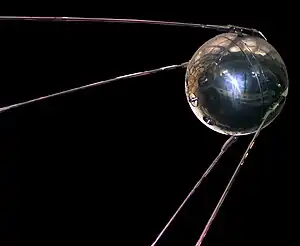
The first artificial satellite was Sputnik 1, launched by the Soviet Union on 4 October 1957 under the Sputnik program, with Sergei Korolev as chief designer. Sputnik 1 helped to identify the density of high atmospheric layers through measurement of its orbital change and provided data on radio-signal distribution in the ionosphere. The unanticipated announcement of Sputnik 1's success precipitated the Sputnik crisis in the United States and ignited the so-called Space Race within the Cold War.
In the context of activities planned for the International Geophysical Year (1957–1958), the White House announced on 29 July 1955 that the U.S. intended to launch satellites by the spring of 1958. This became known as Project Vanguard. On 31 July, the Soviet Union announced its intention to launch a satellite by the fall of 1957.
Sputnik 2 was launched on 3 November 1957 and carried the first living passenger into orbit, a dog named Laika.[11]
In early 1955, after being pressured by the American Rocket Society, the National Science Foundation, and the International Geophysical Year, the Army and Navy worked on Project Orbiter with two competing programs. The army used the Jupiter C rocket, while the civilian–Navy program used the Vanguard rocket to launch a satellite. Explorer 1 became the United States' first artificial satellite, on 31 January 1958.[12] The information sent back from its radiation detector led to the discovery of the Earth's Van Allen radiation belts.[13] The TIROS-1 spacecraft, launched on April 1, 1960, as part of NASA's Television Infrared Observation Satellite (TIROS) program, sent back the first television footage of weather patterns to be taken from space.[14]
In June 1961, three and a half years after the launch of Sputnik 1, the United States Space Surveillance Network cataloged 115 Earth-orbiting satellites.[15] Astérix or A-1 (initially conceptualized as FR.2 or FR-2) is the first French satellite. It was launched on 26 November 1965 by a Diamant A rocket from the CIEES launch site at Hammaguir, Algeria. With Astérix, France became the sixth country to have an artificial satellite and the third country to launch a satellite on its own rocket
France is the third country to launch a satellite on its own rocket, the Astérix, on 26 November 1965 by a Diamant A rocket from the CIEES launch site at Hammaguir, Algeria.
Early satellites were built to unique designs. With advancements in technology, multiple satellites began to be built on single model platforms called satellite buses. The first standardized satellite bus design was the HS-333 geosynchronous (GEO) communication satellite launched in 1972. Beginning in 1997, FreeFlyer is a commercial off-the-shelf software application for satellite mission analysis, design, and operations.
Later Satellite Development

While Canada was the third country to build a satellite which was launched into space,[16] it was launched aboard an American rocket from an American spaceport. The same goes for Australia, whose launch of the first satellite involved a donated U.S. Redstone rocket and American support staff as well as a joint launch facility with the United Kingdom.[17] The first Italian satellite San Marco 1 was launched on 15 December 1964 on a U.S. Scout rocket from Wallops Island (Virginia, United States) with an Italian launch team trained by NASA.[18] In similar occasions, almost all further first national satellites were launched by foreign rockets.
After the late 2010s, and especially after the advent and operational fielding of large satellite internet constellations—where on-orbit active satellites more than doubled over a period of five years—the companies building the constellations began to propose regular planned deorbiting of the older satellites that reached the end of life, as a part of the regulatory process of obtaining a launch license. The largest artificial satellite ever is the International Space Station.[19]
By the early 2000s, and particularly after the advent of CubeSats and increased launches of microsats—frequently launched to the lower altitudes of low Earth orbit (LEO)—satellites began to more frequently be designed to get destroyed, or breakup and burnup entirely in the atmosphere.[20] For example, SpaceX Starlink satellites, the first large satellite internet constellation to exceed 1000 active satellites on orbit in 2020, are designed to be 100% demisable and burn up completely on their atmospheric reentry at the end of their life, or in the event of an early satellite failure.[21]
In different periods, many countries, such as Algeria, Argentina, Australia, Austria, Brazil, Canada, Chile, China, Denmark, Egypt, Finland, France, Germany, India, Iran, Israel, Italy, Japan, Kazakhstan, South Korea, Malaysia, Mexico, the Netherlands, Norway, Pakistan, Poland, Russia, Saudi Arabia, South Africa, Spain, Switzerland, Thailand, Turkey, Ukraine, the United Kingdom and the United States, had some satellites in orbit.[22]
Japan’s space agency (JAXA) and NASA plan to send a wooden satellite prototype called LingoSat into orbit in the summer of 2024. They have been working on this project for few years and sent first wood samples to the space in 2021 to test the material’s resilience to space conditions. [23]
Components
Orbit and altitude control
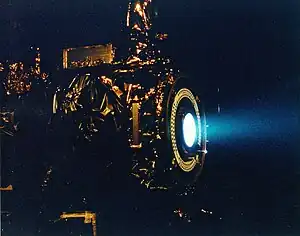
Most satellites use chemical or ion propulsion to adjust or maintain their orbit,[5]: 78 coupled with reaction wheels to control their three axis of rotation or attitude. Satellites close to Earth are affected the most by variations in the Earth's magnetic, gravitational field and the Sun's radiation pressure; satellites that are further away are affected more by other bodies' gravitational field by the Moon and the Sun. Satellites utilize ultra-white reflective coatings to prevent damage from UV radiation.[24] Without orbit and orientation control, satellites in orbit will not be able to communicate with ground stations on the Earth.[5]: 75–76
Chemical thrusters on satellites usually use monopropellant (one-part) or bipropellant (two-parts) that are hypergolic. Hypergolic means able to combust spontaneously when in contact with each other or to a catalyst. The most commonly used propellant mixtures on satellites are hydrazine-based monopropellants or monomethylhydrazine–dinitrogen tetroxide bipropellants. Ion thrusters on satellites usually are Hall-effect thrusters, which generate thrust by accelerating positive ions through a negatively-charged grid. Ion propulsion is more efficient propellant-wise than chemical propulsion but its thrust is very small (around 0.5 N or 0.1 lbf), and thus requires a longer burn time. The thrusters usually use xenon because it is inert, can be easily ionized, has a high atomic mass and storable as a high-pressure liquid.[5]: 78–79
Power

Most satellites use solar panels to generate power, and a few in deep space with limited sunlight use radioisotope thermoelectric generators. Slip rings attach solar panels to the satellite; the slip rings can rotate to be perpendicular with the sunlight and generate the most power. All satellites with a solar panel must also have batteries, because sunlight is blocked inside the launch vehicle and at night. The most common types of batteries for satellites are lithium-ion, and in the past nickel–hydrogen.[5]: 88–89
Communications
Applications
Earth observation
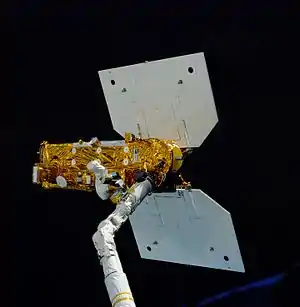
Earth observation satellites are designed to monitor and survey the Earth, called remote sensing. Most Earth observation satellites are placed in low Earth orbit for a high data resolution, though some are placed in a geostationary orbit for an uninterrupted coverage. Some satellites are placed in a Sun-synchronous orbit to have consistent lighting and obtain a total view of the Earth. Depending on the satellites' functions, they might have a normal camera, radar, lidar, photometer, or atmospheric instruments. Earth observation satellite's data is most used in archaeology, cartography, environmental monitoring, meteorology, and reconnaissance applications. As of 2021, there are over 950 Earth observation satellites, with the largest number of satellites operated with Planet Labs.[25]
Weather satellites monitor clouds, city lights, fires, effects of pollution, auroras, sand and dust storms, snow cover, ice mapping, boundaries of ocean currents, energy flows, etc. Environmental monitoring satellites can detect changes in the Earth's vegetation, atmospheric trace gas content, sea state, ocean color, and ice fields. By monitoring vegetation changes over time, droughts can be monitored by comparing the current vegetation state to its long term average.[26] Anthropogenic emissions can be monitored by evaluating data of tropospheric NO2 and SO2.
Communication
A communications satellite is an artificial satellite that relays and amplifies radio telecommunication signals via a transponder; it creates a communication channel between a source transmitter and a receiver at different locations on Earth. Communications satellites are used for television, telephone, radio, internet, and military applications.[27] Many communications satellites are in geostationary orbit 22,300 miles (35,900 km) above the equator, so that the satellite appears stationary at the same point in the sky; therefore the satellite dish antennas of ground stations can be aimed permanently at that spot and do not have to move to track the satellite. Others form satellite constellations in low Earth orbit, where antennas on the ground have to follow the position of the satellites and switch between satellites frequently.
The radio waves used for telecommunications links travel by line of sight and so are obstructed by the curve of the Earth. The purpose of communications satellites is to relay the signal around the curve of the Earth allowing communication between widely separated geographical points.[28] Communications satellites use a wide range of radio and microwave frequencies. To avoid signal interference, international organizations have regulations for which frequency ranges or "bands" certain organizations are allowed to use. This allocation of bands minimizes the risk of signal interference.[29]Spy satellites
When an Earth observation satellite or a communications satellite is deployed for military or intelligence purposes, it is known as a spy satellite or reconnaissance satellite.
Its uses include early missile warning, nuclear explosion detection, electronic reconnaissance, and optical or radar imaging surveillance.
Navigation
Navigational satellites are satellites that use radio time signals transmitted to enable mobile receivers on the ground to determine their exact location. The relatively clear line of sight between the satellites and receivers on the ground, combined with ever-improving electronics, allows satellite navigation systems to measure location to accuracies on the order of a few meters in real time.
Telescope
Astronomical satellites are satellites used for observation of distant planets, galaxies, and other outer space objects.
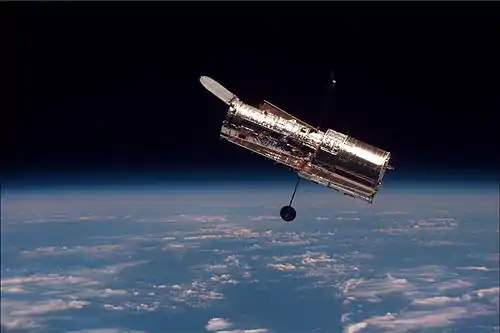
Experimental
Tether satellites are satellites that are connected to another satellite by a thin cable called a tether. Recovery satellites are satellites that provide a recovery of reconnaissance, biological, space-production and other payloads from orbit to Earth. Biosatellites are satellites designed to carry living organisms, generally for scientific experimentation. Space-based solar power satellites are proposed satellites that would collect energy from sunlight and transmit it for use on Earth or other places.
Weapon
Since the mid-2000s, satellites have been hacked by militant organizations to broadcast propaganda and to pilfer classified information from military communication networks.[30][31] For testing purposes, satellites in low earth orbit have been destroyed by ballistic missiles launched from the Earth. Russia, United States, China and India have demonstrated the ability to eliminate satellites.[32] In 2007, the Chinese military shot down an aging weather satellite,[32] followed by the US Navy shooting down a defunct spy satellite in February 2008.[33] On 18 November 2015, after two failed attempts, Russia successfully carried out a flight test of an anti-satellite missile known as Nudol. On 27 March 2019, India shot down a live test satellite at 300 km altitude in 3 minutes, becoming the fourth country to have the capability to destroy live satellites.[34][35]
Pollution and interference
.png.webp)
Issues like space debris, radio and light pollution are increasing in magnitude and at the same time lack progress in national or international regulation.[37][36] Space debris pose dangers to the spacecraft[38][39] (including satellites)[39][40] in or crossing geocentric orbits and have the potential to drive a Kessler syndrome[41] which could potentially curtail humanity from conducting space endeavors in the future.[42][43]
With increase in the number of satellite constellations, like SpaceX Starlink, the astronomical community, such as the IAU, report that orbital pollution is getting increased significantly.[44][45][46][47][48] A report from the SATCON1 workshop in 2020 concluded that the effects of large satellite constellations can severely affect some astronomical research efforts and lists six ways to mitigate harm to astronomy.[49][50] The IAU is establishing a center (CPS) to coordinate or aggregate measures to mitigate such detrimental effects.[51][52][53]
Some notable satellite failures that polluted and dispersed radioactive materials are Kosmos 954, Kosmos 1402 and the Transit 5-BN-3.
Generally liability has been covered by the Liability Convention. Using wood as an alternative material has been posited in order to reduce pollution and debris from satellites that reenter the atmosphere.[54]
Due to the low received signal strength of satellite transmissions, they are prone to jamming by land-based transmitters. Such jamming is limited to the geographical area within the transmitter's range. GPS satellites are potential targets for jamming,[55][56] but satellite phone and television signals have also been subjected to jamming.[57][58]
Also, it is very easy to transmit a carrier radio signal to a geostationary satellite and thus interfere with the legitimate uses of the satellite's transponder. It is common for Earth stations to transmit at the wrong time or on the wrong frequency in commercial satellite space, and dual-illuminate the transponder, rendering the frequency unusable. Satellite operators now have sophisticated monitoring tools and methods that enable them to pinpoint the source of any carrier and manage the transponder space effectively.
See also
Notes
- ↑ to distinguish them from natural satellites.
References
- ↑ "UCS Satellite Database". Union of Concerned Scientists. 1 May 2022.
- ↑ "Rockets in Science Fiction (Late 19th Century)". Marshall Space Flight Center. Archived from the original on 1 September 2000. Retrieved 21 November 2008.
- ↑ Bleiler, Everett Franklin; Bleiler, Richard (1991). Science-fiction, the Early Years. Kent State University Press. p. 325. ISBN 978-0-87338-416-2.
- ↑ "Introduction to satellite". www.sasmac.cn. 2 September 2016. Archived from the original on 16 September 2016. Retrieved 25 May 2022.
- 1 2 3 4 5 Pratt, Timothy; Allnutt, Jeremy E. (2019). Satellite Communications (3rd ed.). John Wiley & Sons Ltd. ISBN 978-1-119-48217-8. OCLC 1098222848.
- ↑ "Preliminary Design of an Experimental World-Circling Spaceship". RAND. July 1946. Archived from the original on 15 June 2010. Retrieved 6 March 2008.
- ↑ Rosenthal, Alfred (1968). Venture into Space: Early Years of Goddard Space Flight Center. NASA. p. 15.
- ↑ "Hubble Essentials: About Lyman Spitzer, Jr". Hubble Site. Archived from the original on 9 October 2018. Retrieved 16 October 2020.
- ↑ R. R. Carhart, Scientific Uses for a Satellite Vehicle, Project RAND Research Memorandum. (Rand Corporation, Santa Monica) 12 February 1954.
- ↑ 2. H. K. Kallmann and W. W. Kellogg, Scientific Use of an Artificial Satellite, Project RAND Research Memorandum. (Rand Corporation, Santa Monica) 8 June 1955.
- ↑ Gray, Tara; Garber, Steve (2 August 2004). "A Brief History of Animals in Space". NASA. Archived from the original on 11 October 2004. Retrieved 12 July 2017.
- ↑ Chang, Alicia (30 January 2008). "50th anniversary of first U.S. satellite launch celebrated". San Francisco Chronicle. Associated Press. Archived from the original on 1 February 2008.
- ↑ "James A. Van Allen". nmspacemuseum.org. New Mexico Museum of Space History. Archived from the original on 15 May 2018. Retrieved 14 May 2018.
- ↑ Tatem, Andrew J.; Goetz, Scott J.; Hay, Simon I. (2008). "Fifty Years of Earth-observation Satellites". American Scientist. 96 (5): 390–398. doi:10.1511/2008.74.390. PMC 2690060. PMID 19498953.
- ↑ Portree, David S. F.; Loftus, Joseph P. Jr. (1999). "Orbital Debris: A Chronology" (PDF). Lyndon B. Johnson Space Center. p. 18. Archived from the original (PDF) on 1 September 2000. Retrieved 21 November 2008.
- ↑ Burleson, Daphne (2005). Space Programs Outside the United States. McFarland & Company. p. 43. ISBN 978-0-7864-1852-7.
- ↑ Mike Gruntman (2004). Blazing the Trail. American Institute of Aeronautics and Astronautics. p. 426. ISBN 978-1-56347-705-8.
- ↑ Harvey, Brian (2003). Europe's Space Programme. Springer Science+Business Media. p. 114. ISBN 978-1-85233-722-3.
- ↑ Welch, Rosanne; Lamphier, Peg A. (2019). Technical Innovation in American History: An Encyclopedia of Science and Technology [3 volumes]. ABC-CLIO. p. 126. ISBN 978-1-61069-094-2. Archived from the original on 14 February 2021. Retrieved 4 October 2020.
- ↑ Slejko, EA; Gregorio, A; Lughi, V (2021). "Material selection for a CubeSat structural bus complying with debris mitigation". Advances in Space Research. 67 (5): 1468–1476. Bibcode:2021AdSpR..67.1468S. doi:10.1016/j.asr.2020.11.037. S2CID 233841294. Archived from the original on 3 June 2022. Retrieved 3 June 2022.
- ↑ Garrity, John; Husar, Arndt (April 2021). "Digital Connectivity and Low Earth Orbit Satellite Constellations: Opportunities for Asia and the Pacific". think-asia.org. Archived from the original on 21 July 2022. Retrieved 3 June 2022.
- ↑ Buchholz, Katharina (4 May 2023). "The Countries with the Most Satellites in Space". statista. Retrieved 11 November 2023.
- ↑ Cairns, Rebecca (11 November 2023). "Japanese scientists want to send a wooden satellite into space". CNN. Retrieved 11 November 2023.
- ↑ "American Elements Assists NASA in Development of Ultra White Coating for Satellite Applications". American Elements. Retrieved 6 April 2023.
- ↑ "How many Earth observation satellites are orbiting the planet in 2021?". 18 August 2021. Archived from the original on 21 July 2022. Retrieved 25 May 2022.
- ↑ NASA, Drought. Archived 19 August 2008 at the Wayback Machine Retrieved on 4 July 2008
 This article incorporates text from this source, which is in the public domain.
This article incorporates text from this source, which is in the public domain. - ↑ Labrador, Virgil (19 February 2015). "satellite communication". Britannica.com. Retrieved 10 February 2016.
- ↑ "Satellites - Communication Satellites". Satellites.spacesim.org. Retrieved 10 February 2016.
- ↑ "Military Satellite Communications Fundamentals | The Aerospace Corporation". Aerospace. 1 April 2010. Archived from the original on 5 September 2015. Retrieved 10 February 2016.
- ↑ Morrill, Dan. "Hack a Satellite while it is in orbit". ITtoolbox. Archived from the original on 20 March 2008. Retrieved 25 March 2008.
- ↑ "AsiaSat accuses Falungong of hacking satellite signals". Press Trust of India. 22 November 2004. Archived from the original on 19 July 2012. Retrieved 19 May 2008.
- 1 2 Broad, William J.; Sanger, David E. (18 January 2007). "China Tests Anti-Satellite Weapon, Unnerving U.S." The New York Times. Archived from the original on 17 April 2017. Retrieved 23 February 2017.
- ↑ "Navy Missile Successful as Spy Satellite Is Shot Down". Popular Mechanics. 2008. Archived from the original on 1 April 2008. Retrieved 25 March 2008.
- ↑ "India successfully tests anti-satellite weapon: Modi". The Week. Archived from the original on 12 July 2021. Retrieved 27 March 2019.
- ↑ Diplomat, Harsh Vasani, The. "India's Anti-Satellite Weapons". The Diplomat. Archived from the original on 1 January 2018. Retrieved 27 March 2019.
{{cite web}}: CS1 maint: multiple names: authors list (link) - 1 2 Lawrence, Andy; Rawls, Meredith L.; Jah, Moriba; Boley, Aaron; Di Vruno, Federico; Garrington, Simon; Kramer, Michael; Lawler, Samantha; Lowenthal, James; McDowell, Jonathan; McCaughrean, Mark (April 2022). "The case for space environmentalism". Nature Astronomy. 6 (4): 428–435. arXiv:2204.10025. Bibcode:2022NatAs...6..428L. doi:10.1038/s41550-022-01655-6. ISSN 2397-3366. S2CID 248300127.
- ↑ Seidler, Christoph (22 April 2017). "Problem Weltraumschrott: Die kosmische Müllkippe – Wissenschaft". Der Spiegel. Archived from the original on 23 April 2017. Retrieved 22 April 2017.
- ↑ Garcia, Mark (13 April 2015). "Space Debris and Human Spacecraft". NASA. Archived from the original on 22 March 2022. Retrieved 22 March 2022.
- 1 2 Williams, Matt. "What would a sustainable space environment look like?". phys.org. Universe Today. Archived from the original on 22 March 2022. Retrieved 22 March 2022.
- ↑ "Chinese official calls for protection of space assets, international coordination mechanisms". SpaceNews. 10 March 2022. Archived from the original on 21 July 2022. Retrieved 22 March 2022.
- ↑ "The Kessler Effect and how to stop it". ESA. Archived from the original on 22 March 2022. Retrieved 22 March 2022.
- ↑ Wattles, Jackie. "Space is becoming too crowded, Rocket Lab CEO warns". CNN. Archived from the original on 26 May 2022. Retrieved 26 May 2022.
- ↑ "What happens if two bits of space junk actually collide?". The Independent. 16 October 2020. Archived from the original on 26 May 2022. Retrieved 26 May 2022.
- ↑ "IAU's statement on satellite constellations". International Astronomical Union. Archived from the original on 27 May 2020. Retrieved 3 June 2019.
- ↑ "Light pollution from satellites will get worse. But how much?". astronomy.com. 14 June 2019. Archived from the original on 28 April 2021. Retrieved 7 November 2019.
- ↑ Hainaut, Olivier R.; Williams, Andrew P. (1 April 2020). "Impact of satellite constellations on astronomical observations with ESO telescopes in the visible and infrared domains". Astronomy & Astrophysics. 636: A121. arXiv:2003.01992. Bibcode:2020A&A...636A.121H. doi:10.1051/0004-6361/202037501. ISSN 0004-6361. Archived from the original on 19 December 2020. Retrieved 22 November 2020.
- ↑ Mróz, Przemek; Otarola, Angel; Prince, Thomas A.; Dekany, Richard; Duev, Dmitry A.; Graham, Matthew J.; Groom, Steven L.; Masci, Frank J.; Medford, Michael S. (1 January 2022). "Impact of the SpaceX Starlink Satellites on the Zwicky Transient Facility Survey Observations". The Astrophysical Journal Letters. 924 (2): L30. arXiv:2201.05343. Bibcode:2022ApJ...924L..30M. doi:10.3847/2041-8213/ac470a. ISSN 2041-8205. S2CID 245986575.
- ↑ "Impacts of Large Satellite Constellations on Astronomy: Live Updates | American Astronomical Society". American Astronomical Society. Archived from the original on 19 April 2022. Retrieved 22 March 2022.
- ↑ Zhang, Emily. "SpaceX's Dark Satellites Are Still Too Bright for Astronomers". Scientific American. Archived from the original on 2 January 2021. Retrieved 16 September 2020.
- ↑ "Report Offers Roadmap to Mitigate Effects of Large Satellite Constellations on Astronomy | American Astronomical Society". aas.org. Archived from the original on 24 September 2020. Retrieved 16 September 2020.
- ↑ "Astronomers stand up to satellite mega-constellations". BBC News. 4 February 2022. Archived from the original on 10 March 2022. Retrieved 10 March 2022.
- ↑ "Protection of the Dark and Quiet Sky from Satellite Constellation Interference". Max Planck Institute for Radio Astronomy, Bonn. Archived from the original on 15 March 2022. Retrieved 10 March 2022.
- ↑ "International Astronomical Union | IAU". www.iau.org. Archived from the original on 13 March 2022. Retrieved 10 March 2022.
- ↑ Harper, Justin (29 December 2020). "Japan developing wooden satellites to cut space junk". bbc.co.uk. Archived from the original on 29 December 2020. Retrieved 29 December 2020.
- ↑ Singer, Jeremy (2003). "U.S.-Led Forces Destroy GPS Jamming Systems in Iraq". Space.com. Archived from the original on 26 May 2008. Retrieved 25 March 2008.
- ↑ Brewin, Bob (2003). "Homemade GPS jammers raise concerns". Computerworld. Archived from the original on 22 April 2008. Retrieved 25 March 2008.
- ↑ "Iran government jamming exile satellite TV". Iran Focus. 2008. Archived from the original on 14 January 2006. Retrieved 25 March 2008.
- ↑ Selding, Peter de (2007). "Libya Pinpointed as Source of Months-Long Satellite Jamming in 2006". Space.com. Archived from the original on 29 April 2008.
External links
- Satellite at Curlie
- EO Portal directory Archived 23 September 2013 at the Wayback Machine